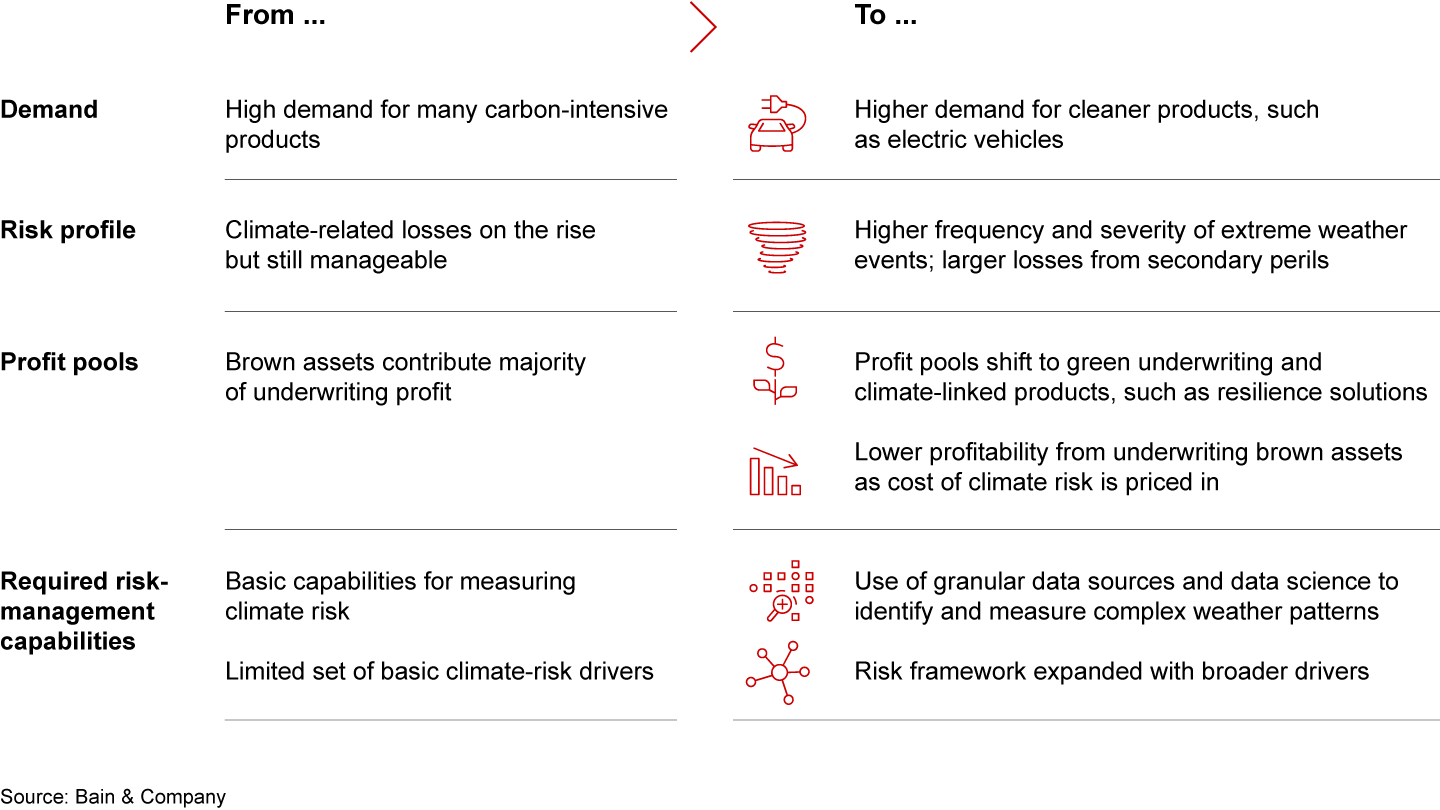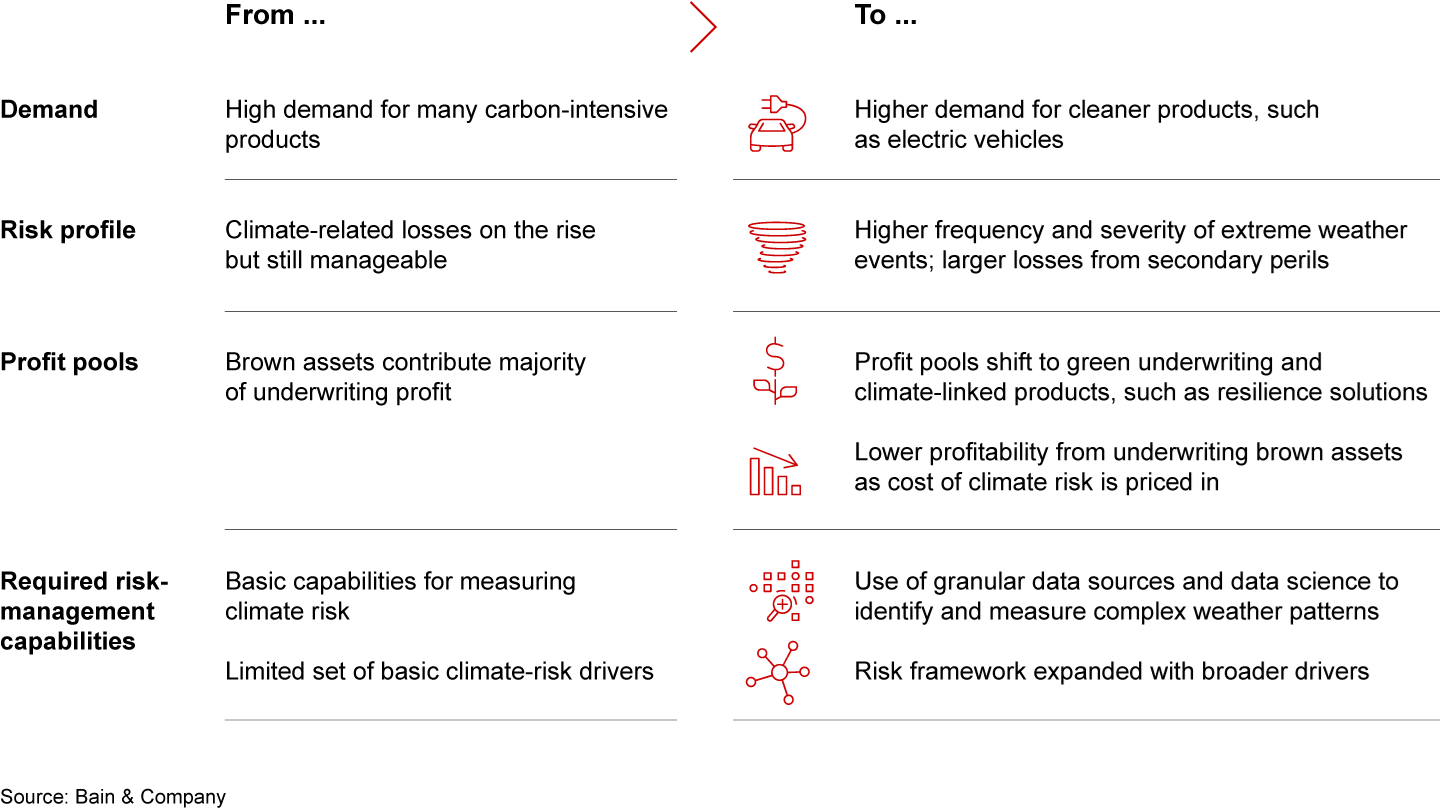Brief

Executive Summary
- The effects of climate change will impose massive direct losses for insurers, as well as transition risks due to changes in government policies and customer preferences.
- On the flip side, insurers that prepare now could improve their economics and thrive through a dual strategy of value preservation and value generation.
- Preservation involves protecting customers and others through risk mitigation and adaptation measures. Generation entails capturing new revenue streams through innovative products and services.
- Success with the dual strategy requires new capabilities around risk modeling, pricing, partnering with external stakeholders, managing sometimes-conflicting pressures from regulators, and influencing customer behavior.
Nature’s volatility is shaking up insurance markets. The effects of climate change can be seen in recent weather events such as the wildfires in Canada and Greece, floods in Libya, and heat waves in the US, Europe, and Asia. Extreme weather will become more and more a part of everyday life. As the backstop for the world’s settlements, insurers themselves face huge consequences, both through greater volumes of climate losses and through shifting customer preferences toward cleaner goods and services.
Yet insurers also have opportunities to preserve and even generate value—and thus improve their economics. As customers’ behavior changes, the nature of protection needs will evolve across regions, perils, and customer segments. Insurers can play a more expansive role than simply risk transfer, such as helping customers mitigate risks before an event occurs.
Total direct losses from physical risks will be substantial over the next three decades, possibly reaching trillions of dollars worldwide and mostly felt by property and casualty (P&C) insurers. In addition, changes in government policies and customer preferences will present transition risks that could reduce revenues by more trillions of dollars. P&C insurers will see reduced premiums as demand for underwriting of carbon-intensive assets drops in developed countries. Insurers’ investment portfolios will see lower returns as brown asset values deteriorate.
More insurers may have to pull back completely from certain markets that they cannot serve profitably, as we’ve seen for P&C in the US states of California and Florida. Insurers also need to incorporate regulatory change in the risk equation, as the pace of climate-related investment regulations has accelerated, especially in Europe. However, insurers that build sufficient capabilities to assess risk and underwrite sustainable assets could offset the revenue lost from climate risks and may even see financial net gains.
A shift in value
What constitutes value in the industry will undergo a big shift. Given greener preferences and greater regulatory focus, climate change won’t just destroy value in some areas; it also represents an opportunity for insurers that build the right capabilities and reposition their business (see Figure 1).
Climate change will both destroy value and create opportunities for insurers’ business


Thriving in this new environment requires a dual strategy. One piece of the strategy involves value preservation—namely, protecting customers, investors, and communities from the negative effects of climate change through risk mitigation and adaptation measures. The second piece involves value generation—that is, capturing new revenue streams through innovation and development of new products and services.
Value preservation
Value preservation consists of risk mitigation and adaptation measures, and, in parallel, upgrading the resilience of infrastructure and other coping measures.
These measures will require new or improved capabilities, such as:
- more sophisticated risk modeling, including better risk data, scenario analysis, and stress testing;
- smarter pricing, as the cost of climate change has not been sufficiently priced into premiums (one complication is ensuring that underserved customers also have protection and vulnerable populations are not left behind);
- risk engineering, through risk transfer mechanisms to reinsurers, customers, and investors;
- partnering with governments and other stakeholders to assemble the best ideas for structural changes; and
- portfolio shaping to influence customer behavior through incentives and policies.
Value generation
As underwriting volumes and investment returns shrink for brown assets, they will grow for green assets like green steel and biofuel. Combined with greater frequency of extreme weather events, this creates demand on several fronts, such as for greater resilience of physical assets. For instance, Zurich already offers risk resilience solutions including brownfield redevelopment due diligence and watershed scale analysis to ensure that wetlands and stormwater areas work together.
In addition, fast-growing business segments focused on decarbonization will seek ancillary products such as project insurance and climate advisory services. Munich Re offers warranty insurance that protects investors and factory owners against the bankruptcy of photovoltaic panel manufacturers.
To execute a new strategy that accommodates the big shift in value, insurers will need to develop the right capabilities and reposition their focus. They will want to expand their risk framework with broader and more detailed climate-risk drivers, so they can accurately underwrite sustainable assets. And they will need to develop a repeatable process for creating, testing, and launching new products, then scaling up the innovations.
History will judge
At the same time, insurers must prepare for a bumpy ride, with many uncertainties that need to be monitored and managed around regulatory developments, new market entrants, and rapid innovation cycles. The value shift discussed here will occur over several decades, but choices over, say, the next five years are not obvious. In this near term, it’s plausible that brown energy becomes expensive due to regulation and that investment in new brown assets declines, also due to regulation; these developments could lead to a large increase in free cash flow from brown assets and high returns on those assets.
Still, the complexities of such a transition imply a first-mover advantage for insurers that explore new growth opportunities now to avoid boxing their core businesses into unattractive corners of the market.
More broadly, the industry can take a leading role in transforming services to benefit society at large, as it has done at other key moments in the past. During the 1860s, for example, British insurers lobbied the national government to offer firefighting services, after incurring huge losses from a massive fire in London.
Similarly today, while the effects of climate change will unfold over many years, insurers should expand their activities in the climate transition. Remaining passive comes with reputational and regulatory risks, whereas proactive firms can gain competitive advantage, build a compelling market narrative, and position themselves to earn a larger share of value.